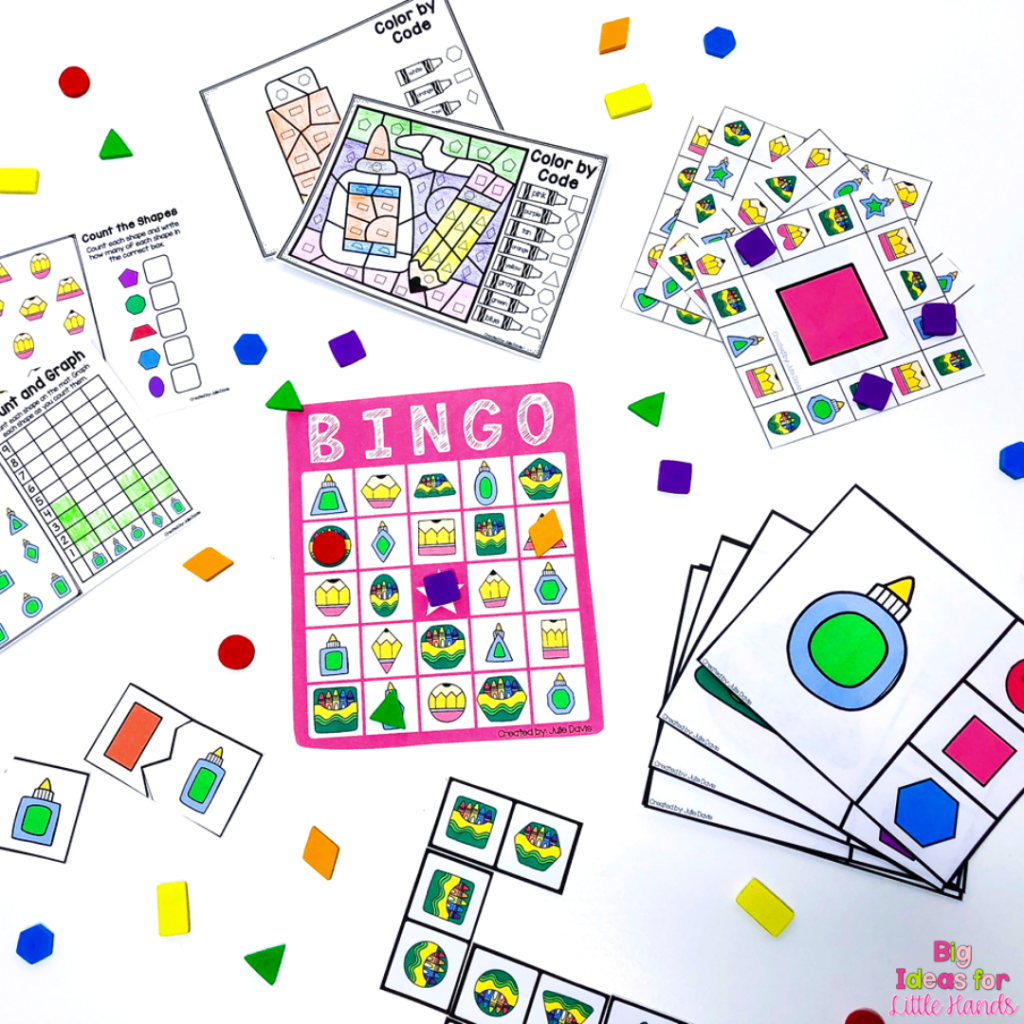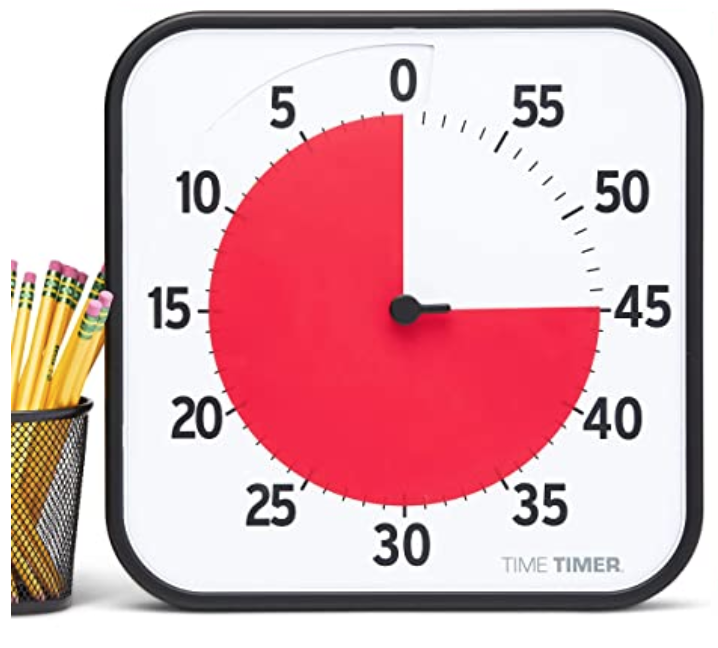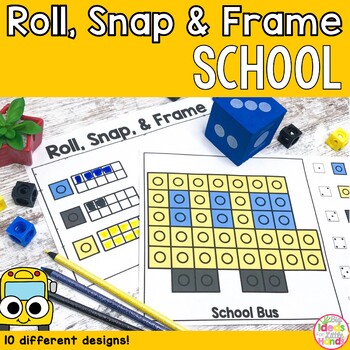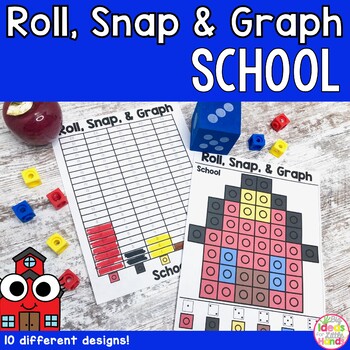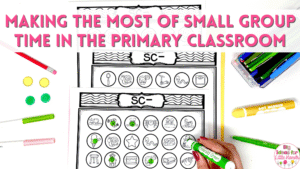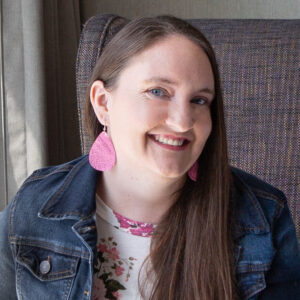I know you see them when scrolling Instagram or searching Pinterest. Those perfectly set up Kindergarten math centers. They look amazing in the photos, but how do you actually make them work in real life? I’m answering your top 5 questions I get when it comes to math centers in Kindergarten, and by the end, I’m positive you will be ready to take them on too!

Math centers in kindergarten sound like a great idea, right? But, you’re worried about the time, energy, and benefits. I’m here to tell you that math centers in Kindergarten can be such an amazing way to help your students grow in their math knowledge AND it doesn’t have to be hard. Here’s everything you need to know to get off on the right foot!
What are Math Centers in Kindergarten?
Math centers in Kindergarten are engaging ways for your students to practice skills they have been learning in your math lessons. Centers give them extra (and typically hands-on) practice to reinforce those skills.
If you are new to the idea of centers, this is a time when several activities are set up in areas around your classroom. Students rotate through the activities practicing math skills and concepts as they go.
Students should be able to easily access the center activities by themselves and work through the concepts with little help from you. This means you want to fill your centers with activities that provide practice and review of skills you have already taught.
You will want to have a variety of activities and materials to meet all of your learners’ needs. This makes the use of centers an amazing way to foster independence and self-directed learning.
How Do You Start and Stay Organized with Math Centers?
Starting math centers in Kindergarten feels overwhelming, but once you answer a few questions, you will easily be able to get them off the ground and running.
1. How do I want centers to be structured in my classroom?
There are two ways you can structure math centers in Kindergarten. The first way is that you choose the activities, set them up, and then let the students choose which activities they want to complete. The alternative is that you assign students to a center and rotate them through all the centers.
At the beginning of the year, I opt for the assigned center rotations. This allows students to focus on the activity and not which center they want to visit. Later in the year, I might give them more choice, but at first, I want to focus on building a solid foundation.
Now, like most things in life, there are pros and cons to both setups, so I urge you to reflect on what you think would be best for your class.
You may have a group of kiddos who are ready to independently decide their centers and get right to work, or your students may need more structure.
Either way, choose a structure, introduce the expectations, and practice, practice, practice. That will be the key to successfully running math centers in Kindergarten.
2. Do I want students to work individually, in pairs, or a combination?
The answer to this question comes down to what you want the purpose of math centers to be in your room. It’s hard to give a hard and fast rule because there are many things to consider. Do you need this to be a time where students work individually to further the skills they may need more practice in? Is this a time where you want to utilize peer models or pair up students based on ability level and direct them to tasks that would be most helpful? Or do you want both?
Additionally, you have to consider your students. If you have an exceptionally chatty class, then partner centers can get a little loud. While this alone is not a problem, it can affect your ability to do small group instruction.
Finally, think about the activities you would like to use. Some activities, like games, lend themselves better to 2 or 3 people. Other activities work better with one person.
Ultimately, be flexible. Try something and don’t be afraid to switch it up if it isn’t working quite right.
3. How will I make the activities and materials accessible for students?
This question helps you get into the meat of how you will organize your centers. Remember, the beauty of centers is that it allows for students to work on not only math but independence, so you want to make sure you organize in a way that allows them to be most independent.
Things you should consider:
- Adding visuals to directions to make them easily understandable
- Modeling activities before adding them to centers
- Storage that students can easily grab, open, and close themselves
Organizing Current Center Activities
I typically like to set up centers in pencil cases, pencil boxes, or Ziploc baggies because students can easily see what materials are inside and can easily open and close these containers. These items also stack nicely on a shelf or can easily be added to a drawer, tub, or bin.
And . . . with all the supplies in one place, students can grab the center and immediately get working.
Storing and Organizing All the Centers
The other side of organizing centers is storing and organizing them when they are not in use. When organizing centers on my end, I find it helpful to organize materials by month and then concept. For example, we learn about 2D shapes in September, so when I prep activities for 2D shapes, I put them in a tote or file box labeled September and then in a hanging file folder labeled 2D shapes. That way when I open the tote, I can easily see all of the concepts I can pull from for September and how many activities I have for each.
This has worked well for me because I have had space to store the large totes and bins. But storage space can be an issue in many classrooms. If you are limited on storage space don’t worry. Look for some creative storage solutions like crate seats or benches that you can store in.
What is the Best Way to Manage Math Centers in Kindergarten?
When it comes to managing math centers in Kindergarten, practice, practice, and more practice is the way to go.

Make sure you have answered the structure question from above before taking on centers. If you are unsure of how it will work or flow, your students will be unsure as well.
This doesn’t mean you can’t modify how centers work in your room throughout the year, but you need to start with a solid foundation.
When you start centers, plan for the first few weeks to be all about practicing the routine versus practicing the content. Go over the expectations each day and slowly give more and more independence.
You don’t have to start with a full set of centers either. Introduce just one or two activities and let students work on those before adding more. Slowly introduce a new center activity every few days.
At the beginning, rotating from one center to the next might be too much for your young kindergarten students. Students can be introduced to centers at a desk or table. Once they are doing well with the procedures for getting, using, and cleaning up supplies, then you can add more.
Some expectations you want to have set include:
- How students will find out which centers to go to
- What materials do they need to bring with them OR where do they find the materials they need
- Where they can find the directions for each activity
- How they will move from one center to the other
- What do they do once they are finished an activity/before they move on to the next center
- What they should do if they need help
- How long they will have at each center
Besides clear expectations and lots of practice, a visual timer can also be your best friend when running math centers in Kindergarten. Having a visual timer will cut down students asking you how long they have left and is a great way for students to know when to transition. There will be a lot of activity and learning going on during centers, so it might be hard to get all of the students’ attention when it is time to transition. But, with a visual timer, the students can listen for the beep and easily transition without you having to do anything! This means you will save time, and we all know how precious our instructional time is!
How Long Should Math Centers in Kindergarten Be?
Ah, the golden question about math centers in Kindergarten: How long should each center be? I wish this was a straightforward answer, but again it depends on a variety of factors.
First, let’s talk about Kindergartner attention span. On average, most 5 to 6 year olds can stay focused on a task for 10-15 minutes depending on the task and their engagement level. So, we most likely don’t want to make a center longer than that span.
Since you will likely be doing small group instruction at the same time, consider how long each group will meet. By making this time match, your small group time becomes one of the centers in your rotation.
When starting out, my suggestion is to start small and then increase the time as students become more familiar with expectations. I like to begin with 10-minute centers at the beginning of the year. This gives time for students to engage with the activity but also provides multiple opportunities for working on those important procedures. Over the course of the year, as the concepts get more difficult, I bump it up to 15 or 20 minutes.
Other Things to Consider . . .
When deciding on how long centers should be, you will also want to consider how many centers students will be completing. Take a look at your schedule to see how much time you have to allocate for centers.
And don’t forget to take into account the types of activities you are having students complete. Playing a game in a pair will probably take longer than completing clip cards. If you have activities that might take longer than you will want to have a longer time at each center. Or if you have shorter activities, you will want to have a shorter time at each center.
It seems intuitive, but I have gotten myself into some real pickles by not considering the length of each activity. Some students were done quickly and itching to move on while others were frustrated they didn’t get to finish before the timer went off.
A great way to head this off is to start preparing students from the very beginning that they may not finish an activity. Make sure they know that there will always be a chance to do the activity again. Likewise, make sure that your procedures include directions for those speedy finishers.
How do Math Centers in Kindergarten Change Throughout the Year?
Typically, when it comes to math centers in Kindergarten, centers are rotated throughout a month and then change each month. For example, you could have math center activities for August and then a set of math center activities for September.
Switching centers by month has several advantages such as:
- Students get multiple exposures to activities and concepts
- Can easily follow the math curriculum
- Allows for seasonal and holiday-themed activities to be easily incorporated
- Easier than organizing by week
- Less prep work for you
Centers would feel completely overwhelming for both you and your students if you tried to create new activities for every day or even week. Simply have a set of activities that cover concepts from that month (or even the previous month’s content!) that you can rotate through. Multiple exposures can be so important for your students, and less prep means you can provide quality practice without losing your sanity!
Try Some Back to School Math Centers for Free!
I know just how amazing and effective math centers can be in the kindergarten classroom. Whether you are just starting out or a seasoned pro, here are some free back to school math centers you can add to your center rotations.
Grab These Low Prep Activities to Make Math Centers in Kindergarten Even Easier
Over the years I’ve created lots of math centers to help my students practice and master important math skills. These no or low prep activities are designed with kindergarten students in mind. I’ve made ready-to-go, engaging centers to help make implementing math centers in Kindergarten as easy as possible for you! These centers are hands-on and interactive with options for individual activities and partner activities.
Here are some of the math centers that my students love year after year.
Looking for ideas for teaching addition in Kindergarten? You can learn more about my favorite activities for teaching addition here.
Check out this video to see these fun and engaging math centers in action!
Save it for Later
Be sure to pin this image to your favorite math activities Pinterest board so you are all set to take on math centers in Kindergarten.


